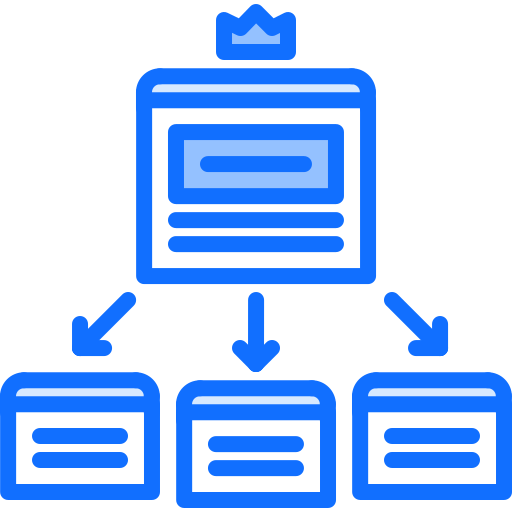Contact us. We are happy to talk about your needs and prepare an offer.
Node.js
One of our technologies, Node.js, supports the creation of event-driven applications. With Node.js, it is possible to build efficient web applications based on the JavaScript language. In addition, the platform runs JavaScript on the server (outside the browser). This technology is the right choice for scalable and efficient web applications and more.

Volume of Work
Node.js is mostly used to create the back-end. We are experts in creating
- interactive web applications,
- systems based on microservers,
- SPA (Single Page Applications), including those optimized for SEO (SSR - Server Side Rendering),
- microservices cooperating with IoT devices.
Operating Area
Our dev team has experience in creating solutions based on Node.js in fields such as:
- business and corporate solutions
- transport and logistics
- distribution
- education
- research
Our Clients
The Advantages of Node.js

One programming language

Short learning curve

Scalability

Fast buffering
What exactly is Node.js?
Node.js is a platform that independently implements JavaScript functionality. This platform employs an API that creates websites based on event-driven programming. Besides the ability to run JavaScript scripts in environments outside of a web browser, the platform provides plenty of modules representing an enormous set of programming tools.
It is worth emphasizing that the technology can be run on various operating systems, such as Linux / Unix, macOS, or Windows.
Node.js is based on the Chrome browser’s V8 engine to accelerate code execution. The engine takes JavaScript code and converts it into faster machine code that can be run on the computer without having to interpret it first. This technology itself is not a server, but it affords the developers the flexibility to create their own web services.
Specification
Node.js has several features that distinguish it from other technologies. The most important are presented below.
Unified language for both the client and the server
A characteristic feature is the implementation of the same language on both the client-side and the server-side of the same application. The code in which the client app is written (i.e. in this case usually the browser) is the same language used to implement the app on the server. Using the same programming language on both sides of the connection precludes much of the duplication of logic usually required in many cross-platform environments.
V8 engine
The Node.js platform is based on the V8 engine, which is an open-source JavaScript engine originally created for Google Chrome. The engine doesn’t interpret JavaScript code in real-time but instead compiles the source code into native machine code, thereby increasing efficiency. Afterward, the optimization process takes place by eliminating dead code and using a branch predictor. Automatic memory management is handled by an efficient ‘garbage collector’.
npm
npm (Node Packaged Module) is a package manager for Node.js used to install Node’s many extensions. Node.js is expanding very dynamically – currently npm catalogs over 250 000 packages, with no end in sight.
Single-threading
Node.js is single-threaded, signifying a departure from the currently popular concurrency model. The Node.js architecture is based on a single-threaded event loop and non-blocking input and output operations that make maximum use of a single processor. As a result, Node.js developers have stopped worrying about the possibility of a completely blocked processor, and the servers became faster and more efficient.
Asynchronous
Most essentially the Node.js environment is asynchronous and event-driven. In the architecture of event-driven programming, the runtime environment of events is not specified. Events are rather handled whenever free resources are available. This results in more efficient use of sources as well as greater code separation and loose coupling. The asynchronous JavaScript environment significantly simplifies the process of building scalable web applications. Furthermore, Node.js handles many connections simultaneously. A callback operates with each connection, but in the case when there is no work to be done, the process automatically goes to sleep. The "hello world" example below shows how to handle multiple connections simultaneously.

The most useful npm modules
npm is one of the most important parts of Node.js. It is a special tool to manage modules. The module ecosystem is open to everyone to publish their own module in it.
The most known and most used npm modules are:
- Express.js - one of the most used frameworks to create web applications
- Hapi.js - a very easy-to-use framework used to create web and service applications
- Connect.js - Extensible HTTP server backbone providing a collection of high-performance plugins known as middleware
- Meteor.js - a framework for quickly creating prototypes and writing cross-platform code that runs on Android, iOS, and Web
- Nest.js - a framework for building efficient and scalable server-side applications
- Socket.io - a library to create applications that ensure real-time communication between the client and the server.
The history of its creation
Node.js is a relatively new technology as it is only 11 years old. It was created in 2009 by Ryan Dahl, and its first version only supported macOS and Linux. Dahl initially developed and maintained the technology himself, but soon received support from Joyent, which became the official sponsor of Node.js.
The idea for Node.js was born due to the limitations of the then most popular web server, Apache HTTP Server. Dahl criticized the server's ability to handle multiple connections (10,000 or more) simultaneously. He noted that when one code is blocked or an alleged stack of multiple executions occurs, the server creates problems that can only be solved with sequential code. Dahl wanted to create a technology that would significantly improve the work of a web server.
Node.js was introduced to the world at JSConf EU 2008, a European conference for the JavaScript community. This technology quickly gained recognition among JavaScript developers, because it enables innovative server-side programming. In January 2010, the npm package manager was released for the Node.js environment. It significantly improved publishing and providing source code for Node.js packages.
In June 2011, thanks to Joyent’s collaboration with Microsoft, a new native version of Node.js supporting Windows was created. A year later, Dahl resigned from work on the further development of Node.js, and his place was taken by the creator of npm, Isaac Schlueter. In 2014, Fedor Indutny launched io.js, which is a compatible Node.js platform. In 2019, the nonprofit Node.js and io.js joined forces to create the OpenJS Foundation.
Some examples of companies whose applications were written using Node.js








The advantages of technology
Thanks to the V8 engine and the use of Javascript, one of the most popular programming languages, Node.js is a frequently chosen technology by developers. However, Node.js has even more advantages that make it a great choice for many projects. Below are presented the most important advantages of this technology.
Scalability
One of the most important advantages of this technology is scalability. Developers appreciate the fact that they can easily scale applications made in the Node.js environment, both horizontally and vertically. Applications can be scaled horizontally by adding new nodes to the existing system. Bear in mind that this technology enables developers to add additional modules also during vertical scaling. In terms of scalability, Node.js offers better capabilities and options than other JavaScript servers.
Ease of learning
Undoubtedly, JavaScript is one of the most popular and used programming languages. Thanks to broadly accessible knowledge of JavaScript, learning Node.js is fast and fun. JavaScript developers adapt very easily to Node.js technology, which in turn leads to faster code writing.
One programming language
Node.js enables creating front-end and back-end in JavaScript. Developers do not have to use different programming languages on the server-side and the technology supports applications on both the client and server sides. This means that applications created in Node.js require fewer files and less code compared to technologies that use different languages for the front-end and back-end parts. Another benefit is that there is no need to hire separate front-end and back-end developers to create the application, which not only reduces costs but also speeds up work.
High performance
As already mentioned Node.js has a Google V8 engine to compile JavaScript code. Compiling significantly speeds up code execution by running the machine code. The engine ensures that both codes are compatible.
Fast buffering
Node.js contains a caching module responsible for loading web pages quickly. Every time an application module receives a request, it is immediately cached in the application's internal memory. This process gives users quick access to web pages.
Multiplatform applications
Thanks to Node.js, developers can use platforms such as Electron or NW.js, which enable building cross-platform web applications in real-time. There is no need to waste time writing separate codes for different systems. What is more, developers have access to more common tools to write and debug code.
Committed community
A thriving community plays a large role in the ongoing development of Node.js technology. Many tools, libraries, and modules facilitating programming in Node.js were created thanks to this community. It is supported by JavaScript developers who are happy to share their proprietary solutions and code by publishing it on GitHub. Node.js is also supported by companies such as Amazon, Google, Facebook, and Netflix. Tech giants very often use Node.js in their projects.
The disadvantages of Node.js
Despite many Node.js advantages, it is not a perfect solution for every project. Below are presented the most crucial disadvantages of this technology.
Loss of performance on large computations
Node.js is not the best choice for projects that require high CPU power. The processor power depends, among other things, on the number and complexity of calculations. The more complicated the calculations, the more power the processor uses to solve it. Due to the blocking of incoming requests by computation, the performance of the technology drops significantly. For this reason, Node.js is not suitable for computationally intensive solutions.
Callback hell
A callback hell is a multiple nested callback function that negatively impacts the quality of the JavaScript code and can also slow down project development. There are now features that alleviate the problems with callbacks. Unfortunately, the available solutions do not completely avoid a callback hell situation.
Frequent code changes due to API changes
The most common errors reported by technology users are frequent API changes that are usually backwards incompatible. Changing the API requires the developer to ensure that the access code is in sync with the latest version of the API.
Tools immaturity
While the core Node.js modules are fairly stable and mature, there are many poor quality or poorly documented tools in the npm registry. In addition, the package manager itself does not have the appropriate structure to offer tools based on their rating or quality. As a result, the developer must determine the best solutions to meet its needs. While the core technology of Node.js is of high quality, many of its community-developed tools are not adequately tested or documented. In addition, some tools do not meet the requirements of sufficiently high quality.
How does Node.js work?

The essence of Node.js is the use of a server engine based on a non-blocking input and output model. JavaScript is translated into machine language quickly and efficiently. The result is a runtime environment in which JavaScript code moves very quickly from server to client. Thanks to Node.js, developers have better abilities to create interactive web pages written in the JavaScript language.
Because of operating on one thread and using a non-blocking input/output model, Node.js supports handling several thousand simultaneous connections stored in the event loop. Data is transferred without continuing to query. All asynchronous tasks are performed by the event loop, which provides a high level of response and thus contributes to increased speed.
Where is it worth using Node.js?
Node.js is used in many projects and fields. Below are listed and described the most popular solutions and industries using this technology.
IoT
Thanks to its specificity and structure Node.js supports a huge number of simultaneous connections. This operation in real-time plays a significant role when choosing the technology for IoT systems. In addition, the technology allows easy integration with various controllers such as Arduino, used very often in building digital devices that create IoT systems. It should be emphasized that many packages have been created that enable faster and more effective integration of technology with devices in the field of IoT.
Chats
Node.js offers the advanced features necessary to create chats of any complexity. With Node.js it is possible to create group chats for real-time conversations based on the IM or IRC (Internet Relay Chat) instant messaging model. The technology works very well with the WebSockets protocol that enables fast two-way exchange of messages between the client and the server over one open connection. The process of building a chat with the use of technology is very simple and consists in installing an appropriate library, e.g. socket.io on the server and client-side.
SPA
Node.js is great for creating single-page applications (SPAs)that appear very similar to desktop applications. Due to its versatile capabilities, Node.js is perfect for building social platforms, dynamic websites, and mailing solutions. The event loop helps manage multiple concurrent client requests, ensuring seamless data updates. In addition, Node.js works very well with data-driven SPA packages. What is more, the technology is written in the same language as the most popular frameworks used to build SPAs, such as Ember, Meteor, React, and Angular. Developers can use the same data structures, modular approaches, and the same language on both the server and client-side. This results in faster SPA development and easier maintenance.
Streaming services
The technology is used to create applications that use streaming data. Node.js provides the ability to transfer some executable code to the local computer while keeping the connection open for new requests. Streaming allows users to both send requests to each other and directly to the destination. No wonder that technology is used by the largest streaming services such as Netflix.
Browser games
This technology is very often used to create online games. Node.js is very easy to integrate with HTML5, which is often used to build games. In addition, the technology has many frameworks such as Express.js and Socket.io, which provide the ability to build browser games such as Ancient Beast or PaintWar.
Node.js popularity
Node.js has been appreciated by developers for many reasons. First, its huge popularity is a result of its JavaScript orientation. Most developers who are familiar with JavaScript will choose a technology that employs that language. Second, being able to develop the front-end and back-end in the same language can be a big help for the development team. A large number of available libraries certainly contributes to the growing popularity. Currently, there are many frameworks that significantly improve the work of developers. The most popular are, among others, Express.js and Socket.io. Another advantage is the npm package manager responsible for efficient library management, thanks to which a programmer can quickly find a library that implements the required functionalities. Besides this, the technology can be run on devices with ARM processors (IoT devices).

If you want to find out more about Node.js or need support in your project - write to us via the contact form.








